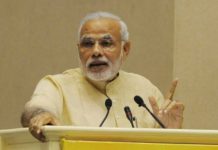
A portly frizzy haired man enters a classroom full of 10-year-old children. “I’m going to give you a question which I have not thought about yet,” he says with a wide smile. The children look bewildered. “It’s a question to which I would not have the answer,” he continues, “you’re going to find the answer.”
“Where did language come from?”
With that he retreats into a corner. Groups of children begin trawling the Internet in search of answers. They consult feverishly with each other, venturing to other groups to find out what they’re doing. Occasionally, a child moves from one group to another.
The man steps forward a little later to ask the children what they’ve found.
“Language comes from the evolution of humankind and how the body is shaped,” ventures a member of one of the groups. “But,” adds another, “they would not have tried to produce sounds if they hadn’t been trying to express their feelings.”
“We’ve observed this happening in classrooms across the world,” whispers Sugata Mitra, professor of educational technology at Newcastle University, UK.
These are concepts that are far beyond their age, yet the children have arrived at them on their own. “Is this a good way to learn?” Mitra asks them. “Yes,” say the children in unison.
It’s a validation of what this 61-year-old professor, winner of the $1 million TED 2013 Prize, has been saying for the last 13 years. Learning in children, he believes, is something that happens almost naturally, a ‘self-organising system’. The lower the adult intervention, the more children are likely to learn.
Mitra is an anachronism in an age that emphasises academic certification and extreme specialisation. He’s part polymath, part dissenter, and perhaps, part visionary.
While studying solid state physics at IIT Delhi in the late 1970s, he discovered that the structure of organic molecules has a greater role in determining their function than their constituent atoms. He then moved on to study energy storage systems, resulting in a new design for zinc-chloride batteries.
This segued into an interest in the way electricity flows through biological systems, which led to a paper that speculated on why human sense organs are located where they are.
Sometime in the ’80s, he’d also developed an interest in computer networking. “I just drifted into it,” he says, “At that time the only people who could create computer programmes were theoretical physicists.”
In 1990, he joined NIIT, where he started work on creating curricula, inventing learning devices and researching new methods of teaching computer programming, which was fast becoming a subject of choice for students around the country.
That was where, one day in 1999, he decided to try an experiment. Computers had entered big schools in every city, and were changing the way children were taught. Would they be of any use to poorer children who had either no access to education or went to schools where the teachers were disinterested and the infrastructure poor, he wondered.
Abutting the wall of his office compound was a slum, the kids of which, even in the off chance that they did go to school, had certainly never used a computer. Mitra bludgeoned a hole in it, into which he stuck a computer. A separate smaller hole housed a track pad. On the computer was an array of educational games and software.
The slum children were quick to explore. Groups of them gathered around this new machine that functioned in a language that none of them knew. It did not take them long, Mitra discovered, to learn to operate it. They fiddled, taught each other and exchanged ideas. In the matter of a few weeks, they’d figured out how the games worked, and more tantalisingly, had even picked up a smattering of English.
Could this be a solution for schools in rural India where there were few good teachers?












